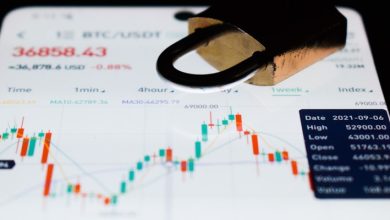The Impact of Market Cycles on Crypto Investment Decisions

- Understanding market cycles in the crypto industry
- How market cycles influence investor behavior in cryptocurrency
- Strategies for navigating market cycles in crypto investments
- The psychological impact of market cycles on crypto traders
- Maximizing returns by timing investments based on market cycles
- Case studies of successful and unsuccessful crypto investments during market cycles
Understanding market cycles in the crypto industry
Understanding market cycles in the crypto industry is crucial for making informed investment decisions. Market cycles refer to the recurring patterns of growth and decline in the value of cryptocurrencies over time. By analyzing these cycles, investors can gain insights into when to buy or sell assets for optimal returns.
One of the key factors influencing market cycles in the crypto industry is investor sentiment. When investors are optimistic about the future of a particular cryptocurrency, its value tends to rise. Conversely, when sentiment turns negative, prices can plummet. This emotional rollercoaster often leads to exaggerated price movements, creating opportunities for savvy investors.
Market cycles in the crypto industry are also influenced by external factors such as regulatory developments, technological advancements, and macroeconomic trends. For example, a government crackdown on cryptocurrency exchanges can trigger a bear market, while the launch of a new blockchain platform can fuel a bull run.
It’s important for investors to recognize that market cycles in the crypto industry are inevitable and part of the natural ebb and flow of the market. By studying historical data and staying informed about current events, investors can better anticipate market movements and adjust their investment strategies accordingly.
How market cycles influence investor behavior in cryptocurrency
Investors in the cryptocurrency market are greatly influenced by the various market cycles that occur. These cycles, which include bull markets, bear markets, accumulation phases, and distribution phases, play a significant role in shaping investor behavior and decision-making processes. During bull markets, when prices are rising and optimism is high, investors tend to exhibit a FOMO (fear of missing out) mentality, leading to increased buying and speculation. Conversely, in bear markets, when prices are falling and sentiment is negative, investors may panic sell or adopt a more cautious approach.
Market cycles also impact investor sentiment and risk appetite. In times of prosperity, investors may take on more risk and leverage in the hope of maximizing profits. However, during periods of downturn, investors may become more risk-averse and opt for safer investment options. Understanding these market cycles and how they influence investor behavior is crucial for making informed investment decisions in the volatile world of cryptocurrency.
Moreover, market cycles can also affect the overall market dynamics and trends. For instance, during accumulation phases, smart money investors may start accumulating assets at lower prices in anticipation of a future bull run. This can create a positive feedback loop, leading to increased demand and ultimately driving prices higher. On the other hand, distribution phases may see large holders selling off their assets, causing prices to decline.
In conclusion, market cycles have a profound impact on investor behavior in the cryptocurrency market. By being aware of these cycles and understanding how they influence market dynamics, investors can better navigate the volatile nature of the market and make more informed investment decisions. It is essential to stay informed, remain patient, and not let emotions dictate investment choices in order to succeed in the ever-changing world of cryptocurrency investing.
Strategies for navigating market cycles in crypto investments
In order to successfully navigate market cycles in crypto investments, it is essential to develop a solid strategy that can withstand the volatility inherent in this space. One key strategy is to diversify your portfolio across different types of cryptocurrencies, as this can help mitigate risk and maximize potential returns. Additionally, staying informed about market trends and news can help you make more informed investment decisions.
Another effective strategy is to adopt a long-term perspective when investing in cryptocurrencies. By focusing on the fundamentals of the projects you are investing in, rather than short-term price movements, you can better weather market fluctuations and position yourself for long-term success.
Furthermore, it is important to set clear investment goals and stick to your plan, regardless of market conditions. Emotional decision-making can often lead to poor investment choices, so maintaining discipline and a rational approach is crucial in navigating market cycles.
Lastly, consider working with a financial advisor or investment professional who has experience in the crypto space. Their expertise can provide valuable insights and guidance that can help you navigate market cycles more effectively and achieve your investment goals. By implementing these strategies and staying disciplined in your approach, you can better position yourself for success in the ever-changing world of crypto investments.
The psychological impact of market cycles on crypto traders
The psychological impact of market cycles on crypto traders can be significant, leading to a range of emotions and behaviors that can influence investment decisions. During periods of high volatility, traders may experience feelings of fear and anxiety, causing them to make impulsive decisions based on short-term market movements. Conversely, during bull markets, traders may feel euphoric and overconfident, leading them to take on excessive risk without fully considering the potential consequences.
Market cycles can also impact traders’ mental well-being, as the constant fluctuations in prices can create a sense of uncertainty and stress. This can lead to emotional burnout and decision fatigue, making it difficult for traders to stick to their investment strategies and maintain a rational mindset.
To cope with the psychological challenges of market cycles, traders can benefit from practicing mindfulness and emotional regulation techniques. By staying grounded and focused on long-term goals, traders can avoid making hasty decisions driven by fear or greed. Additionally, seeking support from a mentor or joining a community of like-minded traders can provide valuable perspective and guidance during turbulent market conditions. Ultimately, understanding the psychological impact of market cycles and taking proactive steps to manage emotions can help traders navigate the crypto market more effectively and make more informed investment decisions.
Maximizing returns by timing investments based on market cycles
Timing your investments based on market cycles can be a strategic way to maximize returns in the world of cryptocurrency. By analyzing the patterns of market fluctuations, investors can make informed decisions on when to buy or sell their assets. Understanding the different phases of a market cycle can help investors anticipate when prices are likely to rise or fall, allowing them to capitalize on potential opportunities.
During the accumulation phase of a market cycle, prices are typically low as investors are cautiously entering the market. This can present a buying opportunity for investors looking to acquire assets at a discounted price before the market enters a growth phase. By purchasing assets during this phase, investors can position themselves for potential gains as the market begins to recover.
Conversely, during the distribution phase of a market cycle, prices are often inflated as investors rush to sell their assets before a potential downturn. Recognizing this phase can help investors avoid buying assets at peak prices and instead consider selling or holding their investments to mitigate potential losses. By understanding market cycles, investors can make more informed decisions on when to enter or exit the market to optimize their returns.
Case studies of successful and unsuccessful crypto investments during market cycles
Investors in the cryptocurrency market have experienced both successes and failures during various market cycles. Let’s explore some case studies of successful and unsuccessful crypto investments:
1. Successful Crypto Investments:
- One investor, John, decided to invest in Bitcoin during a bear market when prices were low. As the market cycle shifted to a bull market, John’s investment grew exponentially, generating significant returns.
- Another investor, Sarah, diversified her portfolio by investing in a mix of established cryptocurrencies and promising altcoins. This strategy helped her mitigate risks and capitalize on the growth of different assets during market cycles.
- Investor Mike took a long-term approach by hodling his crypto assets through market fluctuations. By staying patient and not succumbing to short-term price volatility, Mike was able to ride the wave of market cycles and see substantial gains over time.
2. Unsuccessful Crypto Investments:
- On the flip side, there are also stories of investors who made poor decisions during market cycles. For example, Tom panicked and sold all his crypto holdings during a market dip, missing out on potential gains when prices rebounded.
- Jenny fell victim to FOMO (fear of missing out) and invested a large sum of money in a trendy cryptocurrency at its peak. Unfortunately, the asset quickly lost value, leading to significant losses for Jenny.
- David failed to do proper research and due diligence before investing in a new project. The cryptocurrency turned out to be a scam, causing David to lose all his investment when the project collapsed.
These case studies highlight the importance of strategic decision-making and risk management in crypto investments during market cycles. By learning from both successful and unsuccessful experiences, investors can navigate the volatile crypto market more effectively and increase their chances of achieving profitable outcomes.



